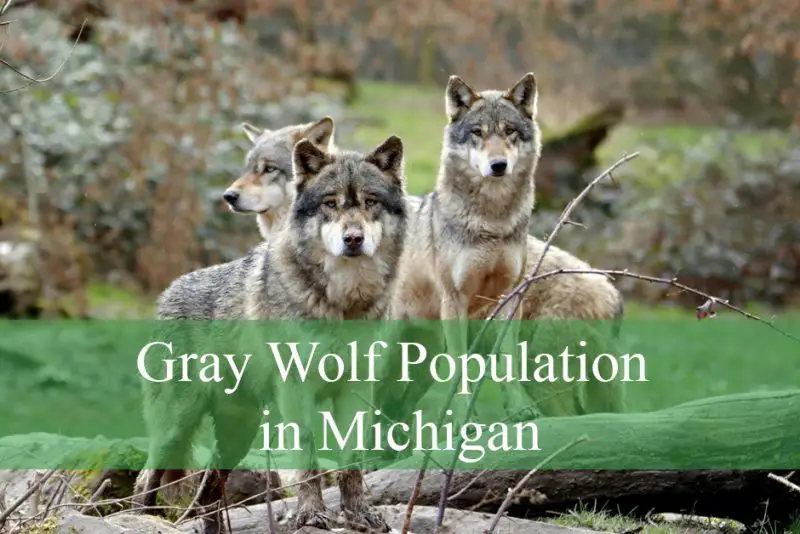Michigan’s wild landscapes tell a story of survival, and among its most fascinating characters is the gray wolf. Once hunted nearly to extinction, the gray wolf population in Michigan has made an extraordinary comeback, drawing attention from wildlife biologists, conservationists, and nature lovers.
This article takes you deep into the heart of the wolves’ journey in the state—unpacking the past, analyzing the present, and exploring what lies ahead for one of Michigan’s most iconic predators.
Historical Presence of Gray Wolves in Michigan

Before settlers arrived, gray wolves roamed freely across Michigan’s Upper and Lower Peninsulas. Native American tribes often respected and revered wolves, viewing them as spiritual guides and important components of the natural world. At that time, wolves followed migrating herds of elk and caribou, thriving in dense boreal forests and open glades.
The shift began during the 1800s as European settlers began expanding across the state. With expansion came conflict: wolves were viewed as threats to livestock, game animals, and human safety. Aggressive extermination programs, including bounties and government-sanctioned hunts, decimated wolf numbers. By the 1960s, wolves had disappeared from Michigan’s Lower Peninsula entirely and were believed to number fewer than 10 individuals in the Upper Peninsula.
This near-extinction echoed across much of the United States. As the keystone predator vanished, ecosystems began to change dramatically, giving rise to overabundant deer populations and unbalanced forest regeneration.
Recovery and Conservation Efforts
In 1973, the passing of the Endangered Species Act marked a pivotal shift in the gray wolf’s fate. Listed as federally endangered, wolves received critical legal protection from killing and harassment. Michigan followed suit by designating the gray wolf as a protected species at the state level.
The Upper Peninsula’s remote forests and connection to Canada and northern Wisconsin served as natural corridors for recolonization. A few wolves migrated into Michigan from neighboring populations in Ontario and Wisconsin during the 1980s. These early pioneers laid the foundation for what would become a slow but steady recovery.
In 1992, Michigan recorded its first confirmed wolf pack in decades. Through continued protection and careful habitat monitoring, wolf numbers began to grow. By the early 2000s, population estimates reached over 200 individuals, and by 2020, the gray wolf population in Michigan had stabilized at over 600—almost entirely within the Upper Peninsula.
Conservation efforts were bolstered by organizations such as the U.S. Fish and Wildlife Service, the Michigan Department of Natural Resources (DNR), and non-profits like Defenders of Wildlife and the National Wildlife Federation. Key actions included radio-collaring wolves, monitoring pack movements, studying prey dynamics, and enforcing anti-poaching laws.
Current Status of the Gray Wolf Population in Michigan
As of the most recent surveys conducted by the Michigan DNR, the gray wolf population in the state is estimated at approximately 600–700 individuals. These wolves are distributed across roughly 150–160 packs in the Upper Peninsula. Each pack typically claims a territory between 50 to 100 square miles, depending on prey availability and environmental factors.
Wolves have been observed dispersing into the northern Lower Peninsula, particularly across the Mackinac Bridge corridor, though there is no confirmed breeding population in that region. Wildlife agencies have installed trail cameras and track surveys to monitor these dispersals.
Michigan’s wolf population is considered biologically recovered. However, because wolves remain a polarizing species, their legal status has shifted back and forth between protected and delisted depending on court rulings and political decisions. Currently, gray wolves are not subject to hunting in Michigan, though legislation regarding potential hunting seasons continues to be debated.
The Michigan Wolf Management Plan, first adopted in 2008 and updated periodically, guides the state’s approach to monitoring, conflict mitigation, and long-term sustainability of wolves.
Ecological Role of Gray Wolves in Michigan
As apex predators, gray wolves perform essential ecosystem services that ripple throughout the natural environment. They help control deer and moose populations, preventing overgrazing and encouraging vegetation diversity. This is especially important in areas where overbrowsing by deer has damaged forest regeneration and reduced plant biodiversity.
Wolves also indirectly benefit other species. For instance, their kills provide scavenging opportunities for animals like eagles, coyotes, and foxes. Their presence can change the movement patterns of prey, reducing localized pressure on fragile ecosystems—a phenomenon known as the “ecology of fear.”
Research in places like Yellowstone National Park has shown how the reintroduction of wolves led to a trophic cascade, benefiting everything from aspen trees to songbirds. In Michigan, similar dynamics have been observed, especially in areas where overabundant deer previously altered natural plant succession.
Challenges and Controversies Surrounding Wolves in Michigan
Despite ecological benefits, wolves remain a flashpoint in rural communities. Livestock depredation, while relatively rare, does occur and can lead to economic hardship for farmers. Michigan DNR offers compensation for verified wolf kills, but some landowners argue that the reimbursement process is slow or inadequate.
In addition, some hunters view wolves as competition for game animals like deer. In regions where deer numbers are already low, wolves are often blamed for further declines, although studies frequently point to factors like habitat quality, winter severity, and human harvest as stronger influencers.
The debate over wolf hunting seasons adds another layer of controversy. Proponents argue that limited hunting would control wolf numbers and reduce conflict, while opponents cite the risk of destabilizing packs, harming ecosystem balance, and reigniting the cycle of decline.
Public opinion polls in Michigan reveal a divided sentiment: while most urban residents support wolf protection, many rural residents are skeptical. Bridging this divide through education, outreach, and fair policies remains one of the greatest challenges for wildlife managers.
Wolf-Human Coexistence and Management Strategies
To foster coexistence, Michigan employs several non-lethal management tools, such as fladry (flagging to deter wolves from livestock areas), livestock guardian dogs, improved fencing, and carcass removal. These methods, when used consistently, have shown success in minimizing depredation.
Educational programs targeting farmers, hunters, and school groups help demystify wolves and encourage science-based thinking. The more communities understand the ecological value of wolves, the more likely coexistence becomes possible.
Additionally, Michigan maintains a Wolf Conflict Response Protocol, which ensures that each depredation event is promptly investigated, verified, and managed using appropriate responses. This protocol aims to balance wolf conservation with the legitimate needs of landowners and local economies.
The Future of the Gray Wolf Population in Michigan
The road ahead for Michigan’s wolves is both promising and uncertain. On one hand, the established packs in the Upper Peninsula appear healthy and genetically stable. On the other, political shifts, legal battles, climate change, and human development continue to shape the landscape in unpredictable ways.
Connectivity between wolf populations in Minnesota, Wisconsin, and Ontario is crucial to ensure long-term genetic diversity. Maintaining wild corridors, preventing excessive road construction, and preserving forest integrity will be vital to ensuring Michigan’s wolves can roam freely.
The potential reestablishment of wolves in the Lower Peninsula remains a subject of interest. While suitable habitat exists in places like the northern Lower Peninsula and parts of the Huron-Manistee National Forests, sustained presence will depend on natural dispersal, low human conflict, and public acceptance.
Ultimately, the gray wolf’s story in Michigan is a powerful symbol of nature’s resilience when given space and protection. It also highlights the complexity of managing large carnivores in shared landscapes.
FAQs about Gray Wolf Population in Michigan
How many gray wolves currently live in Michigan?
As of the most recent estimates from the Michigan Department of Natural Resources, the gray wolf population in Michigan is approximately 600 to 700 individuals. These wolves are primarily found in the Upper Peninsula, where habitat conditions are most favorable for their survival.
Are gray wolves found in both the Upper and Lower Peninsulas of Michigan?
Gray wolves are currently established only in the Upper Peninsula. While occasional sightings and tracks have been reported in the northern parts of the Lower Peninsula, there is no confirmed breeding population in that region at this time.
What caused the decline of gray wolves in Michigan?
The decline of gray wolves in Michigan was primarily due to habitat loss, widespread hunting, trapping, and government-sponsored extermination programs during the 19th and 20th centuries. By the 1960s, they were nearly extinct in the state.
How did the gray wolf population recover in Michigan?
The recovery began in the 1970s following the federal listing of gray wolves as an endangered species under the Endangered Species Act. Protection from hunting, coupled with natural migration from nearby regions like Wisconsin and Ontario, allowed wolves to repopulate suitable habitats in Michigan.
Are gray wolves in Michigan still protected?
Yes, gray wolves in Michigan are currently protected and cannot be hunted legally. Their legal status has changed over time due to federal and state court rulings, but as of now, they are not subject to recreational hunting.
Do gray wolves pose a threat to humans?
Gray wolves are generally shy and avoid contact with humans. Attacks on people are extremely rare. Wolves may prey on livestock or domestic animals in certain situations, but they do not typically pose a direct threat to public safety.
What do gray wolves eat in Michigan?
Gray wolves primarily prey on white-tailed deer, which are abundant in Michigan. They may also hunt smaller mammals like beavers and hares, and occasionally scavenge carrion. Their diet plays a key role in regulating prey populations and maintaining ecological balance.
Are there any programs to compensate for livestock losses caused by wolves?
Yes, Michigan offers compensation to livestock owners for verified wolf depredation events. The Michigan DNR works closely with farmers to investigate and confirm losses and offers support to implement preventive measures.
Can gray wolves be reintroduced to the Lower Peninsula?
There are no current plans for an active reintroduction of wolves to the Lower Peninsula. However, natural dispersal from the Upper Peninsula or neighboring regions could eventually lead to the establishment of a population if suitable habitat and public acceptance are present.
Why is the gray wolf important to Michigan’s ecosystem?
Gray wolves serve as apex predators, helping to regulate prey species like deer. This predation prevents overgrazing and promotes healthier forests. Their presence contributes to biodiversity and overall ecological stability in Michigan’s wild landscapes.






